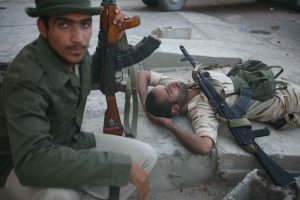The Privatisation of Post-modern Insurgencies
One of the most noticeable features of a number of the conflicts I have reported on in the last few years is how often one side tends to be represented by a spectrum of diverse armed groups, often with very local roots, in competition with both monolithic regular forces and with each other. In Iraq, before the US withdrawal, that latter opponent was the Iraqi government’s forces backed by American forces; in Libya the Gaddafi regime; in Syria today it is the regime of Bashar al-Assad.
Libyan opposition fighters rest during the battle for Sirte copyright – Peter Beaumont
There was much talk about five years or so ago about the privatisation of conflict in the west by the widespread use of contractors, but we seem to be seeing another, perhaps more complex aspect of that privatisation taking place, not least in Syria.
Groups compete for control of areas and for resources from donors – both state and private individuals in the Gulf. As in Iraq where different kinds of extortion or the take over of valuable enterprises like petrol stations by groups was not uncommon, groups in Syria have been accused of using their position to enrich themselves, often through looting with groups becoming larger or smaller depending on the resources they can both appropriate in their area or how much assistance from outside is forthcoming.
Charles Lister, attempting to to cut through the good guys-bad guys depiction of opposition groups describes the dynamic well.
While numbers and force deployment capabilities are clearly very important, they are not the be all and end all. Like it or not, groups on the more extreme end of the spectrum, particularly those affiliated with al Qaeda, have proven remarkably adept at spreading their military resources across large swathes of territory, joining battles at the pivotal moment, and exploiting their superior organizational structures to establish political control and influence over territory. While some moderate groups have also presented tight levels of organization and command and control, jihadist and Salafist insurgent groups have by and large been notably more effective in this regard.
The conflict itself also cannot be presented as a single dynamic or theater of battle. Instead, as the number of involved groups has proliferated and the armed conflict is now well into its third year, countless unique and sometimes interdependent theaters have emerged, each with its own distinctive characteristics and inter-group dynamics. While all micro theaters see distinctly local insurgent groups operate, nearly all of them involve larger single militant organizations or multi-group alliances which have come to operate on a more national basis, hence the countless unique dynamics across the country.
Lister concludes with thoughts about what this means for Syria’s future:
Looking further into the future, these complex dynamics appear to be gradually generating a discernible division between those who support the SNC’s vision for Syria’s future and those who oppose it and want a notably more Islamic state. Neither of these end points should necessarily be seen as right or wrong and it is by no means impossible that they couldn’t be combined.
Another thought occurs to me, is not whether there might be a later tension between different visions in the opposition over the country’s future but – in the event of a change of regime at some point in the future – whether we might see a repetition of what happened in post-Gaddafi Libya. There different katibas with different city or regional loyalties came into competition because of the sense of entitlement that stemmed from the perception over how much they had contributed or suffered, the city of Misrata being a case in point. In other words the way such conflicts are fought can be seen as a predictor of future political post-conflict stability.


Recent Comments